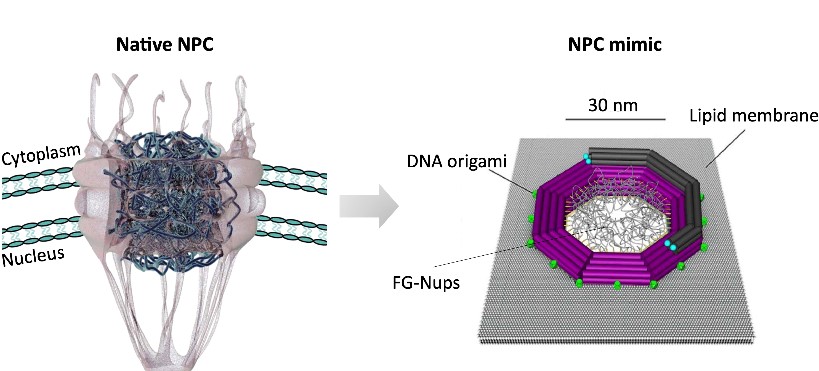| Cees Dekker Lab in the spotlight: exploring life at the nanoscale |
| |
Author: Violet van Houwelingen, who conducted interviews with various members of the Cees Dekker Lab.

At the Cees Dekker Lab, all the hard work of DNA and proteins comes alive on the tiniest scale. Building on the foundations of Cees Dekker’s discoveries on carbon nanotubes and the application of nanotechnology to biology, the team studies DNA and proteins one on one in vitro, while slowly starting to combine them to build up life’s emerging properties. Roman Barth, PhD student in the group: “The fact that you can take SMC proteins outside of the cell and still see them at work is fascinating.”
The Cees Dekker Lab explores life at the nanoscale. What does that mean? “At our lab we want to understand the physical principles underlying biology. That’s a common theme,” says Cees. “I am fascinated with living things and how they work: What is life? I moved into the field of biophysics to study this question. My lab does a wide array of things, because I’m interested in so many different things. Our work for example covers the areas of nanopores, DNA-protein interactions, and synthetic cell division. I’m fascinated by the wonders that biomolecules can do. Proteins, for example, can form motors that burn fuel, move, rotate, generate ATP, etc.”
“At the end of the 90s, I started applying the tools of nanotechnology to biology. In our research on carbon nanotubes, we managed to drive electrical current through a single molecule between nano-electrodes, building a transistor from that. Around the year 2000, I changed course to study the physics of biological systems. For example, we started making nanopores to study DNA sequencing, biophysics, and nuclear pore transport. A nanopore is simply a tiny hole in a membrane but it’s surprisingly versatile – this year’s Nobel Prize for medicine is just another example illustrating that. Nowadays you can even read off information of the base sequence of DNA that goes through the nanopore. Recently we started to expand this concept to protein sequencing.”
Studying the gatekeepers of the nucleus
“We also study nuclear pore complexes (NPC), which are the small holes which you find in the membrane surrounding your cell’s nucleus,” Cees continues. “The NPC are the gatekeepers of your nucleus as they regulate all the transport of molecules in and out of the nucleus. Interestingly, the NPC allows selective transport of only certain molecules, while it blocks others. By mimicking the NPC with nanopores and attaching nuclear pore proteins we study the mechanisms of this transport through the NPC.”
Alessio Fragasso is a PhD student in the Cees Dekker lab who studies the NPC: "My research focuses on the selective behaviour of the NPC,” says Alessio. “Proteins called FG-Nups fill the pores and select which proteins can go through while excluding all the others. We try to understand what the minimal features are for such selectivity using rationally designed FG-Nups that we build ourselves ‘from scratch’. We also try to better mimic the NPC, with the use of DNA-origami scaffolds to spatially organize FG-Nups. I find it fascinating to apply state-of-the-art nanotechnology to mimic and study biology at the nanoscale.”

Description: Left: Structure of the nuclear pore complex in cells. Right: Mimic of this NPC made using DNA origami in a lipid membrane
Studying the compaction of DNA
“Another area of our research is DNA-protein interactions” Cees goes on. “For example, we study the structure and dynamics of chromosomes at a nanoscale, to understand basic phenomena in cell biology: how is DNA coiled up in chromosomes? How do proteins organise the genome into a useful structure? Humans have a meter of double stranded DNA in their chromosomes, all packed up in the nucleus. Our lab looks at all the different ways in which this compaction of DNA occurs. There are proteins that can bind and bend the DNA for example, and motor proteins which compactly fold the DNA by making loops inside the chromosomes. We use optical microscopy to resolve this, as well as a scanning probe microscopy.”

PhD student Roman Barth looks at SMC proteins in the lab, ring-shaped proteins that give structure to chromosomes: “These proteins extrude loops of DNA in vitro,” explains Roman. “In my research, we study how SMC proteins can extrude DNA loops outside of the cell, to understand how looping of our genome is regulated in living cells: are there roadblocks that can form an obstacle for SMC proteins? We also explore why DNA looping takes place at all, apart from the sole compaction of the genome: Is it involved with gene regulation for example, or DNA repair? The fact that you can take these SMC proteins outside of the cell and still see these loop extruders working is fascinating to me.” |
|
|
|
|
| |
Description: Video of a SMC protein extruding a DNA loop and, while doing so, incorporating a road block into the loop which was bound to the DNA (here a dCas9): large nanoparticles are thus no real obstacle for SMC proteins.
Studying fantastic protein patterns
PhD student Sabrina Meindlhumer focuses on pattern formation by Min proteins: “Min protein are a group of protein in E. coli which determine the axis along which cell division will happen,” Sabrina explains. “In vivo, Min protein form pole-to-pole oscillations. This type of process is referred to as biological pattern formation. In an artificial environment, MinD and MinE will bind to supported lipid bilayers and form a large variety of patterns, such as spirals or travelling waves. I work together with a theoretical group in Munich, to compare our experimental outcome to what theory says the patterns should be like. There are still lots of unknown details to discover in this system, and just looking at all the diverse patterns which the Min protein form on a membrane is fascinating.” |
|
|
|
Description: MinD (magenta) and MinE (green) on a supported lipid bilayer.
Bottom-up biology
Cees Dekker addresses the third main area of the lab, bottom-up biology: “About 10 years ago, we started thinking about building synthetic cells from the bottom up. A number of things characterize living organisms, like confinement, reproduction, evolution, energy flow. Yet, we lack a good definition of what is life. The approach of the Building a Synthetic Cell consortium (BaSyC) is to put purified proteins into vesicles and thus hope to generate life-like properties. I hope that this type of research will help clarify the definition of what life is. A dream of our lab is to realise synthetic cell division. So far that’s been rather unsuccessful but that’s part of the research, exploring various ideas and meandering our way forward.”

Description: Liposomes are used as models for synthetic cells.
“Our latest project is called Genome-in-the-box, named after the ‘particle in a box’ to describe quantum states,” Cees continues. “We take the genome out of an E. coli bacterium and strip it of all its proteins. Then we start adding bending proteins, motor proteins, or others. In this way we can study all these effects separately and attempt to start building these chromosomes from the bottom-up: first study each of them separately and then combine them to build up the emerging properties.”

Description: The lab aims to study how chromosomes are built up from DNA and protein components
Sharing tricks and feedback across the teams
Do the researchers in the Cees Dekker Lab also exchange ideas beyond their own topic? They do, Sabrina explains: “It’s true that our topics are quite specialised, but still we can discuss on multiple levels. We work with similar techniques, so we can exchange a lot about whatever tricks and applications we need in the lab. We also discuss the content of our work in meetings, across different teams. We give each other feedback, which is very helpful: Sometimes another person thinks of something that your group has not thought of before, because you are so focused on one aspect.”
What are the dynamics of the scientists working at the lab? Cees: “We have a big team of about 20 postdocs and PhDs, and this is continuously in flux. In the past summer 7 people have said goodbye, a lot. But 5 new persons will start up between now and January again. It’s a very international group from all over the world. They are driven, bright young scientists from quite a range of backgrounds: from biophysics and bio-engineering to chemistry and biology. I feel very privileged to be working with all these PhDs and postdocs.”
More information
Cees Dekker Lab |
|
|
|
 |
| |
|